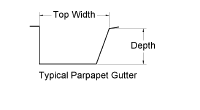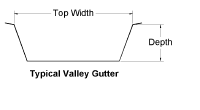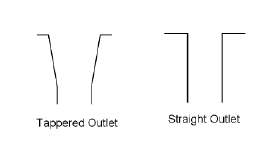| From 1st April 2002, Drainage and Waste
Disposal Approved Document H of the Building Regulations came into force.
Section H3 relates to Rainwater Drainage.
|
| The regulations give detailed advice on rainfall rates, gutter and
outlet sizes for half round eaves gutters. For other types of gutters the
regulations recommend that the design be carried out in accordance with BS
EN 12056-3:2000 Gravity drainage systems inside buildings - Part 3: Roof
drainage layout and calculation. This standard replaces BS6367:1983 Code
of practice for drainage of roofs and paved areas. |
|
Design Rainfall Rates |
| BS6367 gave rainfall rates in mm/hr whereas the
new standard gives design rainfall rates in l/s per mē, to convert to
mm/hr multiply by 3600. |
Eaves Gutters and Flat Roofs
The main change in BS EN 12056-3 from the previous standard is the design
rainfall rate, whereas previously a design rainfall rate of 75mm per hour
was used for eaves gutters and flat roofs, now the standard recommends a
rainfall intensity for a 2 min duration storm event with a return period
of 1 year as the basis of design. |
| Depending whereabouts in the country you are,
the rate will vary from 0.01 l/s per mē (35mm per hour) to 0.022 l/s per
mē (80mm per hour) |
Valley and Parapet and Boundary Wall
Gutters
Generally two categories of design rate should be considered depending on
the return period required: |
1.5 x Building design life
4.5 x Building design life |
| For a building of say a design life of 30
years, this would give a return period of 45 years and 135 years
respectively. The standard gives rainfall intensity maps for differing
return periods 5, 50 and 500 years. |
| I would suggest that in the absence of more
detailed information that for normal risk building use the return period
50-year map and for high risk building e.g. museums use the return period
500-year map. |
| Based on the a rainfall intensity map for a 2
min duration storm event with a return period of 50 years, the rainfall
rate will vary from 0.02 l/s per mē (72mm per hour) to 0.056 l/s per mē
(201mm per hour). |
| For the a rainfall intensity map for a 2 min
duration storm event with a return period of 500 years, the rate will vary
from 0.032 l/s per mē (115mm per hour) to 0.088 l/s per mē (317mm per
hour). |
|
Gutter Types |
| Eaves gutters are defined as gutters where any
spillover will discharge outside the building, whereas with valley and
parapet gutters, any overflow will discharge inside the building. |
| The width and depth of eaves gutters will
depend on the area to be drained, outlet and rainwater pipe size and
position. |
| For valley and parapet gutters it is
recommended that the gutter should be large enough to enable a person to
walk on them for maintenance and cleaning, for valley gutters the top
width should not be less than 500mm and for parapet gutters 300mm. The
depth of the gutter will again depend on the area to be drained, outlet
and rainwater pipe size and position, although I would suggest a minimum
depth of 150mm. |
|
 |
 |
|
Design Procedure |
| The standard gives detailed advice and
calculation procedure for the design of roof drainage systems |
| As a guide: |
1. Calculate the run-off for each length of
gutter for a given rainfall rate and rainwater pipe position.
2. Calculate the capacity of the gutter
3. Calculate the capacity of the outlet in the gutter
4. Calculate the capacity of the rainwater pipe |
| If the capacities in steps 2, 3 and 4 are
greater than the run-off from step 1 then the system is satisfactory. Otherwise
vary the positions of the rainwater pipe, or gutter and outlet sizes until
the system is satisfactory. Often changing the outlet type from a straight
drop outlet to a tapered outlet will prove effective. |
|
 |
| For easy to use tables to determine gutter
sizes and outlet positions - see the
Drainage
section |